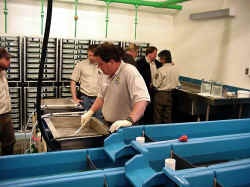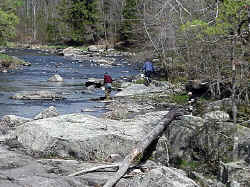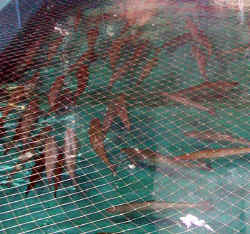Bibliography Background About KRIS
Maine Hatcheries and Atlantic Salmon Restoration
Baum (1997) gives a complete history of hatcheries and stocking of Atlantic salmon in Maine all the way back to 1862 and defines several eras. The earliest efforts were driven by depletion of stocks through non-sustainable fisheries (i.e. 1880 Penobscot fishery with 230 traps and 36 gillnets) coupled with habitat loss due to dams. The first major hatchery in New England was Craig Brook Hatchery, which is a conservation hatchery today but was established to maintain and supplement fisheries that had been so vitally important during early settlement. Early failures lead to a high mortality but experiences lead to advancements in fish culture, although all juvenile salmon were stocked as fry. Charles Atkins, a major figure in the development of Craig Brook Hatchery and fish culture in Maine, continued experiments with different techniques of out-planting in a 53 year career spanning from 1867 to 1920. He was one of the first to use the automobile to disperse fry in headwater areas, where Atkins believed they would have a greater chance of survival (Baum, 1997).
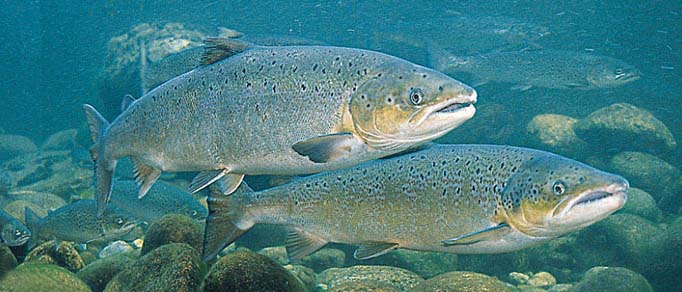
Photo courtesy of Maine Atlantic Salmon Commission.
For more than 100 years the hatchery model was based on the industrial revolution concept of interchangeable parts instead of an understanding of the uniqueness of salmon stocks (see Fish Populations in Gulf of Maine Background page). Eggs from the Penobscot River were exported throughout the region and to places as far distant as Minnesota and Iowa, Ecuador and England (Baum, 1997). The approach to fish culture was also entrepreneurial with Craig Brook's operation funded from fees paid by states that received Atlantic salmon eggs. Pacific salmon were introduced to Atlantic salmon rivers from 1862 to 1940 under the false hope that introductions would add new "species to the fishery resources of Maine" (Smith, 1896 as cited in Baum, 1997). From 1920 to 1937, the U.S. Bureau of Fisheries changed hatchery policies and began to produce almost exclusively brook trout eggs, which were in high demand. Under this new policy, Canadian Atlantic salmon eggs were imported and brook trout eggs were supplied to Canada in return.
Beginning in about 1940, Maine began a more scientific approach to salmon management, and fish passage and other habitat issues began to be addressed. Hatchery policies returned to use of Maine stocks, however, only 50% of the fry were required to be planted back in streams from which eggs were taken (Baum, 1997). In 1953, Craig Brook Hatchery was rebuilt after a flood and modernized, which allowed more rearing of juvenile Atlantic salmon to the parr and smolt stage. This practice was also justified because more than a decade of monitoring showed poor results from fingerling plants. Fish planted at larger sizes had higher return rates, although they often returned at a younger age from the ocean than native fish or those stocked as fry. The improved output capability at Craig Brook, according to The Maine Atlantic Salmon Task Force (1997), helped increase salmon numbers: "The increased production of hatchery-reared salmon, in addition to improved water quality, new or improved fish passage facilities, and reductions in distant water commercial fisheries, dramatically increased Maine salmon runs and sport fisheries during the 1970s and 1980s." Not until 1991 was the practice of planting Penobscot River salmon in other Downeast rivers discontinued.
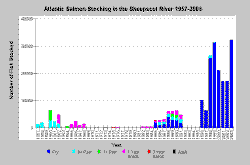 This chart from KRIS Sheepscot shows stocking of Atlantic salmon in the Sheepscot River each year by life stage from 1957-2003. From 1957 to 1991, most of the fish stocked were from older age classes and may have come from various salmon rivers. In 1992, a river specific stocking program started using mostly fry in order to maintain the age of return of the adult population. The most recent plants are from native, capative broodstock from the Sheepsvcot River raised at Craig Brook Hatchery. Data were contributed by the US Fish and Wildlife Service, Craig Brook National Fish Hatchery.
This chart from KRIS Sheepscot shows stocking of Atlantic salmon in the Sheepscot River each year by life stage from 1957-2003. From 1957 to 1991, most of the fish stocked were from older age classes and may have come from various salmon rivers. In 1992, a river specific stocking program started using mostly fry in order to maintain the age of return of the adult population. The most recent plants are from native, capative broodstock from the Sheepsvcot River raised at Craig Brook Hatchery. Data were contributed by the US Fish and Wildlife Service, Craig Brook National Fish Hatchery.
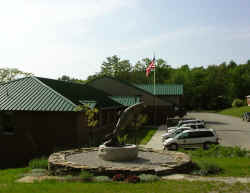 In 1992, the state of Maine began to work in closer cooperation with the U.S. Fish and Wildlife Service on Atlantic salmon culture and Craig Brook Hatchery was converted from a production hatchery to one dedicated to restoration (Baum, 1997). In an effort to maintain genetic strains of wild Atlantic salmon, juveniles have been captured from the various DPS rivers and reared through to adults. "This affords an opportunity to protect and maintain these populations until environmental conditions become more favorable to the survival of the salmon through natural cycles, and as a result of habitat protection and enhancement being conducted by agencies and watershed councils" (USFWS/NOAA, 2000). From 1992-1996 over 5,000 wild-origin juvenile Atlantic salmon were collected and reared to adulthood in captivity and spawned at Craig Brook. Over 1.2 million river-specific fry were stocked back in the Dennys, East Machias, Machias, Narraguagus and Sheepscot rivers in that period.
In 1992, the state of Maine began to work in closer cooperation with the U.S. Fish and Wildlife Service on Atlantic salmon culture and Craig Brook Hatchery was converted from a production hatchery to one dedicated to restoration (Baum, 1997). In an effort to maintain genetic strains of wild Atlantic salmon, juveniles have been captured from the various DPS rivers and reared through to adults. "This affords an opportunity to protect and maintain these populations until environmental conditions become more favorable to the survival of the salmon through natural cycles, and as a result of habitat protection and enhancement being conducted by agencies and watershed councils" (USFWS/NOAA, 2000). From 1992-1996 over 5,000 wild-origin juvenile Atlantic salmon were collected and reared to adulthood in captivity and spawned at Craig Brook. Over 1.2 million river-specific fry were stocked back in the Dennys, East Machias, Machias, Narraguagus and Sheepscot rivers in that period.
In addition to planting juvenile Atlantic salmon back to their native rivers, surplus adults raised as captives at Craig Brook are also released back to their native rivers to spawn in the wild. "Broodstock that are surplus to the needs of the hatchery are returned to their river of origin. In 1996, 503 adult fish were returned to their rivers, 583 in 1997, 907 in 1998, and 81 in 1999" (USFWS/NOAA, 2000). The Atlantic Salmon Commission (Kircheis, 2001) reported that redds in the lower Sheepscot River were an indication that Craig Brook excess adults had spawned in the wild.
Potential Continued Threats of Hatchery Operation to Gulf of Maine Atlantic Salmon Recovery
Although the sanctioned program for planting of Atlantic salmon is now in conformance with the best conservation hatchery principals, there is still concern over operation of private Atlantic salmon hatcheries on Maine rivers, which provide fish for aquaculture, and from the side effects of state run hatcheries that raise other game fish species (USFWS/NOAA, 2000).
The private Atlantic salmon hatcheries on the Pleasant and Union rivers often hatch eggs that are of nonnative origin. Escape of these juveniles into the wild is considered a "take" under the Endangered Species Act (USFWS/NOAA, 2000). Mills (1991) points out that transplanting stocks of Atlantic salmon "may erode genetic variability and will change genetic profiles in wild populations resulting in possible breakdown of adaptive gene complexes." If the number of strays is high and the native population low, consequences can be serious for the locally adapted population.
Pollution from hatcheries from both disease organisms and nutrients was recognized as a potential threat by Dill et al. (2002). (See also Aquaculture Background page). With regard to nutrient pollution Dill et al. (2002) made the following observations:
"All five of these hatcheries discharge wastewater into adjacent or nearby rivers, lakes, or streams with little or no treatment other than settling ponds to separate out solids. The U.S. Environmental Protection Agency has identified eleven pollutants of concern that are commonly associated with hatchery effluents. They include: solids, nitrogen, phosphorous, organic compounds and BOD, salts and trace elements, odors and volatile compounds, pathogens (human and fish), pesticides, antibiotics, other chemicals and nonnative species and escapement."
The Palermo Hatchery on the Sheepscot River, run by the Inland Fisheries Division of Maine, is a concern because it diverts Sheepscot River flow below Sheepscot Pond and its effluent is a source of nutrient pollution (Arter, 2002). Monitoring of hatchery outfall by IFD is required by the Maine Department of Environmental Protection as part of the permit for discharge issued to the hatchery for biological oxygen demand (BOD), total suspended solids (TSS), phosphorous, nitrogen and ammonia (Arter, 2004).
NAS (2003) expressed concern about the river specific stocking program currently being used to revive critically depleted native Gulf of Maine Atlantic salmon:
"Hatcheries need to continue to be used, at least in the short term, to supplement wild populations and to serve as a storehouse of fish from the various rivers. There is an urgent need to understand the relative efficiency of stocking of different life stages in the rivers in terms of adult returns per brood-stock fish and their reproductive success. Additional research on hatcheries and scientific guidance for their use is needed, because hatchery-based restoration of wild salmon populations remains an unproven technology."
NAS (2003) also specifically mentioned risk of "adverse genetic and ecological effects" that should be the focus of monitoring and advisedmanagers to respond to new findings through adaptive management by making appropriate changes to the conservation hatchery program.
References
Arter, B. S. 2004. Sheepscot River Water Quality Monitoring Strategic Plan: A guide for coordinated water quality monitoring efforts in an Atlantic salmon watershed in Maine. Prepared for the Project SHARE: Research and Management Committee. 84 pp. [975kb]
Baum, E., 1997. Maine Atlantic Salmon: A National Treasure. Hermon, ME:, Atlantic Salmon Unlimited. 224 p.
Dill, R., C. Fay, M. Gallagher, D. Kircheis, S. Mierzykowski, M. Whiting, and T. Haines, 2002. Water quality issues as potential limiting factors affecting juvenile Atlantic salmon life stages in Maine rivers. Report to Maine Atlantic Salmon Technical Advisory Committee by the Ad Hoc Committee on Water Quality. Atlantic Salmon Commission. 28 pp. [162kb]
Kircheis, F.W., 2001. Annual Report to the Maine Legislature Fish and Wildlife Committee for the period January through December 2001. Maine Atlantic Salmon Commission, August, Maine. 59 p. [1.4 Mb]
Maine Atlantic Salmon Task Force. 1997. Atlantic Conservation Plan for Seven Maine Rivers. Task Force Appointed by the Governor of Maine. 383 p. [1.6Mb]
Mills, D. 1991. Ecology and Management of Atlantic salmon. Chapman and Hall, University Press, Cambridge, U.K. 351 p.
National Research Council. 2003. Atlantic Salmon in Maine. The Committee on Atlantic Salmon in Maine, Board on Environmental Studies and Toxicology, Ocean Studies Board, Division on Earth and Life Sciences. National Research Council of the National Academies. National Academy Press. Washington, D.C. 260 pp. [3.5Mb]*
USFWS and NOAA. 2000. Endangered and Threatened Species; Final Endangered Status for a Distinct Population Segment of Anadromous Atlantic Salmon (Salmo salar) in the Gulf of Maine. Federal Register Notice Vol. 65, No. 223 / Friday, November 17, 2000 / Rules and Regulations. Pages 69459-69483.[225 kb]
